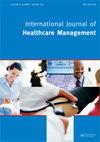Trends in utilization of off-pump coronary artery bypass graft surgery in the US
IF 1.1
Q4 HEALTH POLICY & SERVICES
International Journal of Healthcare Management
Pub Date : 2023-10-26
DOI:10.1080/20479700.2023.2270288
引用次数: 0
Abstract
ABSTRACT.Coronary artery bypass graft (CABG) surgery is the mainstay for surgical treatment of coronary artery disease. CABG is performed in one of two ways: (1) while the heart is temporarily arrested, and a patient receives cardiopulmonary bypass (‘on pump’); or (2) without cardiopulmonary bypass with the heart still beating (‘off pump’). This observational study using data from 2004-2015 from the Healthcare Cost and Utilization Project National Inpatient Sample (HCUP-NIS) examined trends in utilization and outcomes (in-hospital mortality, length of stay (LOS), hospital costs, and selected post-operative complications associated with on and off pump CABG. Overall, there was a declining trend in the number of CABG procedures. Off-pump procedure patients had significantly higher unadjusted mortality rates and longer LOS, but without significantly higher costs. There was a lower risk of post-operative stroke associated with off-pump procedures, but an increased occurrence of post-operative sepsis. One possible explanation is that more patients may be receiving angioplasty, which may have increased the pool of CABG patients with higher risk factors. Hospital administrators may use this information to optimize patient outcomes in cardiovascular surgery units. Future research should seek to control for patient level risk factors in the selection of surgical procedure.KEYWORDS: Coronary artery diseasecoronary artery bypass graftCABGcardiopulmonary bypassoff-pump coronary artery bypassutilizationHCUP-NIS Disclosure statementNo potential conflict of interest was reported by the author(s).Authorship contribution statementCatherine Z. Baumgardner, PhD: Conceptualization (supporting); Writing – original draft (equal); Writing – review and editing (equal); Project administration (supporting); Supervision (supporting).Amber Schilling, PharmD: Data curation (supporting); Formal analysis (equal); Writing – original draft (equal); Writing – review & editing (equal).Diane Spokus, PhD: Writing – original draft (equal); Writing – review & editing (equal).Zachary Henderson, MHA: Writing – original draft (equal); Writing – review & editing (equal).Mark Suzuki, MD: Writing – review & editing (equal).Christopher S. Hollenbeak, PhD: Conceptualization (lead); Data curation (lead); Formal analysis (equal); Project administration (lead); Supervision (lead)Additional informationFundingThe author(s) reported there is no funding associated with the work featured in this article.Notes on contributorsCatherine Z. BaumgardnerDr Catherine Z. Baumgardner is a leadership scholar and Teaching Professor at The Pennsylvania State University. Her research focuses on leadership and organization development in healthcare, with a special emphasis on physician leaders.Amber SchillingDr Amber Schilling is a pharmacist who works as an independent consultant on a wide variety of health outcomes and value-based research projects. She has partnered with clients in both industry and academia. She resides in the Washington, DC metro area.Diane SpokusDr Diane Spokus is a Teaching Professor in the Department of Health Policy and Administration at The Pennsylvania State University. She also holds the Master Certified Health Education Specialist credential and serves on a hospital board. Her research focuses on healthcare workforce training and development with specific interests in aging policies.Zachary HendersonZachary Henderson, MHA, FACHE, CMPE is a Regional Operations Manager working for Geisinger Health System. He has over a decade of experience leading a variety of specialty practices. His operational knowledge is rooted in streamlining efficient processes and building a team culture to drive results.Mark SuzukiDr Mark Suzuki is board certified in Cardiothoracic and General Surgery and has specialized clinical training in both cardiothoracic and cardiovascular surgery. He is affiliated with Piedmont Augusta, University Health System.Christopher S. HollenbeakDr Christopher S. Hollenbeak is a health economist and Professor and Department head in Health Policy and Administration at The Pennsylvania State University. His research focuses on value and outcomes in healthcare.非体外循环冠状动脉搭桥手术在美国的应用趋势
摘要冠状动脉旁路移植术(CABG)是治疗冠状动脉疾病的主要手术方法。冠状动脉搭桥有两种方式:(1)在心脏暂时停止跳动时,患者接受体外循环(“有泵”);或者(2)不进行体外循环,心脏仍在跳动(“停泵”)。这项观察性研究使用了2004-2015年医疗成本和利用项目国家住院患者样本(HCUP-NIS)的数据,研究了使用趋势和结果(住院死亡率、住院时间(LOS)、住院费用和与开泵和关泵CABG相关的术后并发症)。总体而言,冠状动脉搭桥手术的数量呈下降趋势。非泵手术患者的未调整死亡率明显更高,LOS更长,但费用没有明显增加。与非泵手术相关的术后卒中风险较低,但术后败血症发生率增加。一种可能的解释是,更多的患者可能正在接受血管成形术,这可能增加了具有较高风险因素的CABG患者的数量。医院管理人员可以使用这些信息来优化心血管外科单位的患者预后。未来的研究应寻求在选择手术方式时控制患者水平的危险因素。关键词:冠状动脉疾病冠状动脉旁路移植术冠状动脉旁路移植术心肺旁路移植术体外泵冠状动脉旁路移植术披露声明作者未报告潜在利益冲突。作者贡献声明catherine Z. Baumgardner, PhD: Conceptualization(支持);写作-原稿(同等);写作——审稿与编辑(同等);项目管理(支持);监督(支持)。Amber Schilling,药学博士:数据管理(支持);形式分析(相等);写作-原稿(同等);写作-审查和编辑(同等)。Diane Spokus,博士:写作-原稿(平等);写作-审查和编辑(同等)。Zachary Henderson, MHA:写作-原稿(相等);写作-审查和编辑(同等)。马克铃木,医学博士:写作-审查和编辑(平等)。Christopher S. Hollenbeak博士:概念化(lead);数据管理(领导);形式分析(相等);项目管理(领导);监督(领导)额外信息资金来源作者报告说,没有与本文所述工作相关的资金。Catherine Z. Baumgardner博士是宾夕法尼亚州立大学的领导力学者和教学教授。她的研究主要集中在医疗保健的领导和组织发展,特别强调医师领导。Amber Schilling博士是一名药剂师,在各种健康结果和基于价值的研究项目中担任独立顾问。她与工业界和学术界的客户都有合作。她住在华盛顿特区都会区。Diane Spokus博士是宾夕法尼亚州立大学卫生政策与管理系的教学教授。她还持有硕士认证健康教育专家证书,并在一家医院董事会任职。她的研究重点是医疗保健劳动力的培训和发展,并对老龄化政策有特殊兴趣。Zachary Henderson, MHA, FACHE, CMPE是Geisinger Health System的区域运营经理。他拥有超过十年的领导各种专业实践的经验。他的运营知识植根于精简高效的流程和建立团队文化以推动结果。Mark Suzuki是心胸外科和普通外科的认证医师,并在心胸外科和心血管外科方面接受过专门的临床培训。他隶属于皮埃蒙特奥古斯塔大学卫生系统。克里斯托弗·s·霍伦比克博士是宾夕法尼亚州立大学卫生政策与行政学院的卫生经济学家、教授和系主任。他的研究重点是医疗保健的价值和结果。
本文章由计算机程序翻译,如有差异,请以英文原文为准。
求助全文
约1分钟内获得全文
求助全文
来源期刊

International Journal of Healthcare Management
HEALTH POLICY & SERVICES-
CiteScore
5.40
自引率
9.50%
发文量
77
 求助内容:
求助内容: 应助结果提醒方式:
应助结果提醒方式:


